“And then, suddenly, we’re in the midst of radiant sunshine above the fog. And everything calms in the mind: the immense blue of the sky, the blaze of the sun, the endless landscape of clouds underneath make a boundless peace seep into the mind.” …..Mika Waltari, 1937
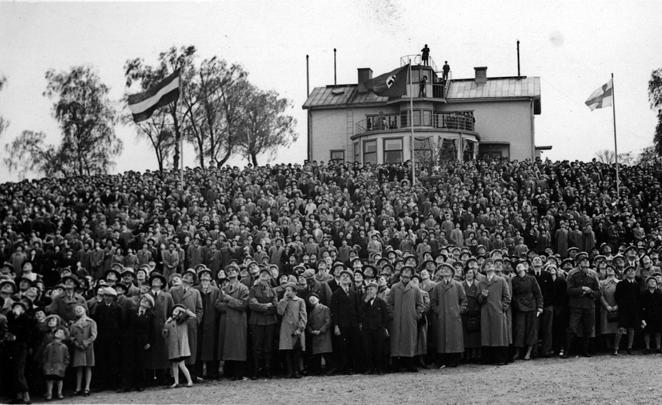
The opening ceremony of Artukainen Field in Turku on 8 September 1935. Photo: G. Ståhle collection
In the 1920’s, air travel was still in its infancy and passenger air traffic was scarce. The modest route network consisted of both land airports and air harbors. The Nordic countries with their coastlines and lakes were especially suited for seaplane traffic. As a consequence, a perfunctory attitude towards building expensive land airports prevailed in Finland – the land of a thousand lakes with its long coastline was perfect for seaplane traffic, flown already in 1924 by the domestic airline Aero Oy.
By the early 1930’s, however, land airports for passenger traffic had already established themselves in continental Europe to a degree that was making air harbors for seaplanes and floatplanes obsolete as elements of the expanding route network. From the point of view of the rest of Europe, Finland resembled an island. Thus it was imperative to keep up with development, and in the early 1930’s the planning of land airports commenced in the major cities of Finland. By the end of the decade, regular traffic was already served by several airports such as Artukainen Field in Turku, Malmi Airport in Helsinki, Oritkari Field in Oulu and the airfields of Vyborg, Imatra, Vaasa and Kemi.
The first-generation passenger airports in Finland were mostly austere and simple, and their modest wooden terminals and hangars did not aim for architectural merit. The international airports, Artukainen in Turku and Malmi in Helsinki, were an exception. Artukainen Field was the first land airport for passenger traffic in Finland. It was ceremoniously inaugurated by President P.E. Svinhufvud in September 1935. The steward’s residence of old Artukainen Manor had been modernized in the functionalist style to serve as the terminal. Artukainen Field was an important gateway for international traffic and an intermediate point on the route from Helsinki to the brand new Bromma Airport in Stockholm, Sweden. The route was opened in late 1936 when the runways of Helsinki-Malmi Airport had been completed. Artukainen Field also served regular domestic traffic to the new land airports in Helsinki and Vaasa.
The Construction of Malmi Airport
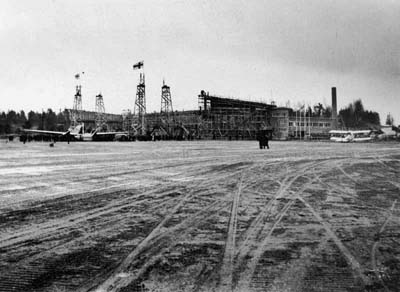
The roof of the hanger being built in 1937
Prior to the contrsuction of Malmi Airport, the area of Tattarisuo was a swamp. But elsewhere throughout the world Governments encouraged the building of land airports near the most significant cities. In spite of Finlands thousands of lakes, the era of floatplanes was coming to an end in Finland. Many were still nostalgic and harbored rosy dreams: “Maybe after all… fields should be saved for agriculture”. The relatively young Finnish state was looking for a location for its capital’s airport. The City Council of Helsinki decided to try and take the easy way out, in 1932 offering the worthless seafront of northern Vanhakaupunki as a location for the new land airport.
Thus, the city would get rid of a piece of wasteland and the State would build and pay for the airport needed by Helsinki. Those in charge of the matter did not fall for this and turned the offer down. The next location was found in 1933 far from the city center, on the fields of Tuomarinkylä. The area was prime-quality farmland, and the farmers shed copious tears over the matter. An alternative was sought after, and then someone came up with Tattarisuo by Malmi. In May 1935, the City of Helsinki and the State signed an agreement to build the airport. The City allocated a 55-hectare area in Tattarisuo to the State’s needs for a period of 99 years (The agreement is valid until the year 2034).
The loudest critic of the airport-to-be was the most famous Finnish aviator and expert, Captain Väinö Bremer, who reminded everyone of the dangers and troubles the treacherous swamp would bring along. Nobody believed him. On a worthless swamp (from the City’s point of view) the State built an airport with four 800-meter runways, and a 104-meter-long hangar which in the drawing board phase was the biggest in Europe at that time. In addition, an administrative building with a passenger lounge, a restaurant, a meterological station and a control tower, a Customs office and other necessary facilities were to be erected. The airport was equipped with the most modern lighting and communications systems which represented the peak of know-how and technology of the time.
The Difficult Beginning
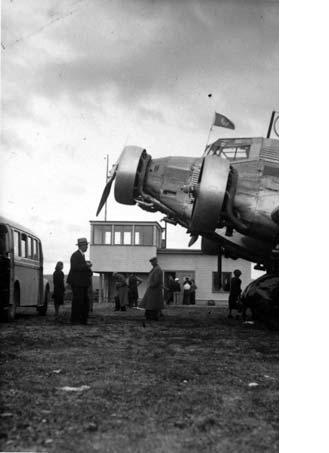
Smaller Airports had a rather more primitive infrastructure – The Terminus of the “Lapland Express” – Yläluostari Field (Petsamo)
The swamp didn’t surrender to the constructors easily. With the machinery and tools of that time the task had seemed impossible. Horses and carriages were felt to be best suited for the job, and temporary tracks criss-crossed the swaying swamp. A man and a shovel rose n priority as the bottomless swamp came up with all kinds of surprises. The subsurface drainage and sewerage system of the area proved to be the key prerequisite to the whole project. The massive buildings of Malmi Airport were erected not only to serve their purpose but also as monuments of sleek 1930’s functionalist architecture. The airport terminal building was designed by Dag Englund, a well-known young Finnish architect and the airport as a whole was an impressive avant-garde achievement that won international recognition.
Malmi Airport was the first airfield in Finland to be designed from scratch, buildings and all, as an international passenger airport. Its 2.400-ft concrete-paved runways, built on difficult ground, as well as the instrument approach systems and other equipment represented the most modern way of airport-building in those days. Traffic began in December 1936, when only the runways had been completed, to save the capital from being left out of the route network as all passenger aircraft were quickly converted from floats to wheels for operation from the land airports in Turku and Stockholm. At that time the terminal and the hangar were still under construction.
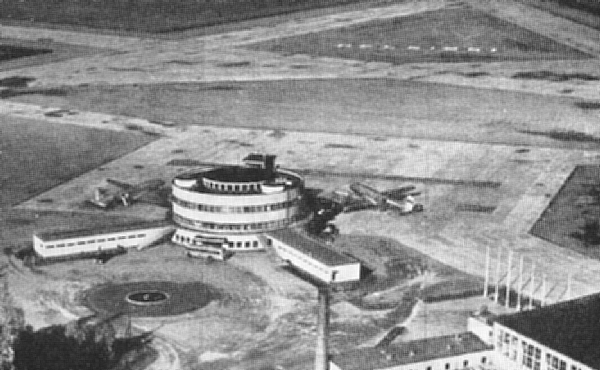
Malmi Airport Terminal Building Post-WW2 but structurally unchanged from it’s pre-War opening
The functionalist buildings of Malmi Airport were designed by Dag Englund, Onni Ermala and Vera Rosendahl of the office architect group of the Board of Public Buildings. The shining white, round terminal building with its wings and continuous view balcony was sited in the optimal location towards the runways. The semicircular restaurant offered an excellent view of both the air traffic and the bustle of the departures and arrivals lounge. The stylish 300-ft hangar was, upon its completion in 1937, the second largest in Europe and could accommodate six large Junkers Ju-52 airliners. The hangar was also fully equipped for the maintenance and repairs of aircraft, engines and propellers.
But in the end all obstacles were surmounted and the airport construction was completed. Modest air traffic began on the 16th of December 1936, and in the turn of the year 1936-1937 the air route between Malmi-Turku-Stockholm was opened. The Swedish AB Aerotransport operated the flights and a bit later Aero Oy’s aircraft joined in when the Junkers 52/3m aircraft had been stripped of floats and re-equipped with landing gear. In the year 1937 some 15,000 passengers departed from and arrived at Malmi. Compared to the numbers of passengers at present-day Helsinki-Vantaa Airport, this figure seems amusingly small, but so were the aircraft.
The Junkers 52, known as “Junnu”, could take on 14 passengers and a crew of three. In 1937, the number of passenger seats was increased to sixteen. In the middle of the same year, 14 scheduled flights a day landed at and departed from Malmi to the most important cities in Europe, even to Jerusalem with a connection via Warsaw (The longest air route in Europe, flown by LOT, reached from Helsinki to Jerusalem with the 2,800-mile journey taking a day and a half). A flight to London took 11 hours, to Berlin seven hours, and one could get to Stockholm in just a couple of hours. Among foreign airlines, the Polish LOT and the Swedish ABA were represented, as was Lufthansa. One could get from Helsinki to Stockholm in two hours, and by summer 1938 the international routes of Aero Ltd had been extended to Berlin – a six-and-a-half hour journey – via Tallinn, Riga, Kaunas and Königsberg.
A Reminder from Tattarisuo Swamp
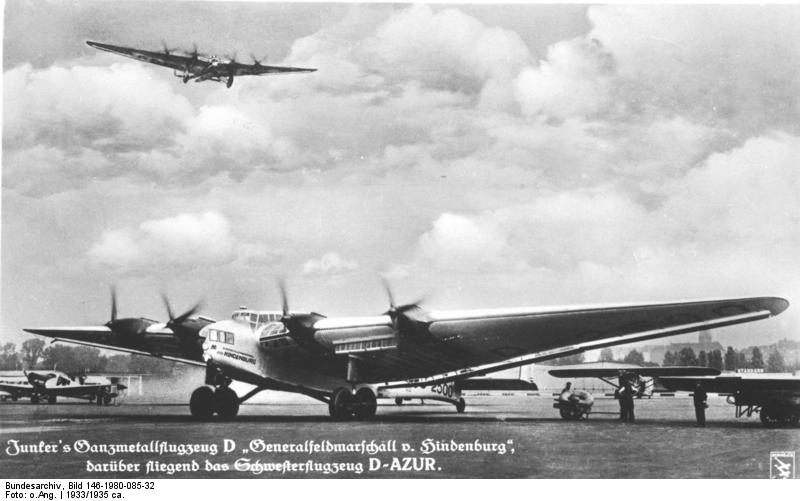
Junker`s G38 Ganzmetallflugzeug D “Generalfeldmarschall v. Hindenburg”, darüber fliegend das Schwesterflugzeug D-AZUR.
On Thursday, 29 July 1937 at 5 o’clock in the afternoon the pride of Germany, the giant of the skies, the Junkers G-38 “Generalfeldmarschall von Hindenburg” landed at Malmi Airport. Among others, the Councillers of the City Council of Helsinki had hurried straight from their meeting to witness this wonder. In front of the administrative building stood a huge corrugated-steel four-engined Junkers with four-blade propellers. It had brought the Latvian team to participate in the World Shooting Championship Contest being held in Helsinki.
The aircraft had been built as early as 1931, when diesel engines were still believed in as aircraft power plants. It had four 750-horsepower engines, a cabin with two decks and room for 34 passengers, a crew of seven (including on board mechanics who were able to service the engines in flight due to the G.38’s blended wing design which provided access to all four power plants) and a fully furnished dining room. The G.38, during its early life, was the largest land plane in the world, the passenger accommodation was sumptuous by today’s standards and was meant to rival that found on the competing Zeppelin service offered by DELAG.
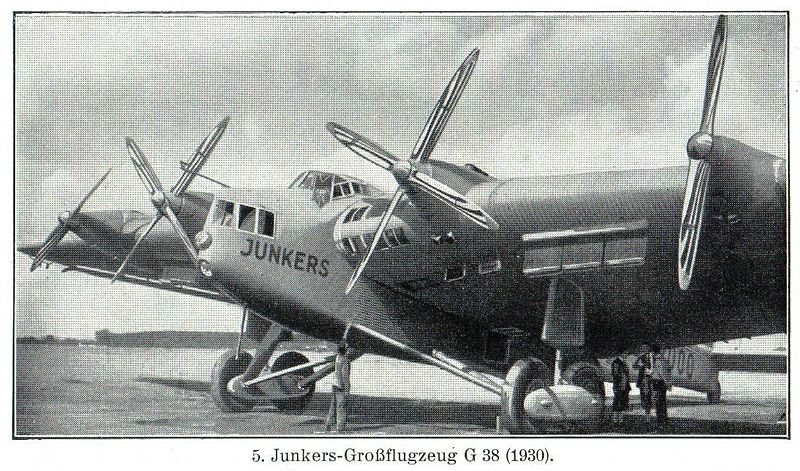
Junkers G-38 – II
The plane was unique in that passengers were seated in the wings, which were 1.7 m (5 ft 7 in) thick at the root. There were also two seats in the extreme nose. The leading edge of each wing was fitted with sloping windscreens giving these passengers a forward-facing view usually available only to pilots. There were three 11 seater cabins, plus smoking cabins and wash rooms. The aircraft was also equipped with modern Telefunken radios and radio navigation equipment.
This visit was also the last one for this aircraft; when preparing for take-off, it sank axle-deep into the swamp at the end of the runway close to Tapanila. The pride of Germany lay in the bog, and the prophecy of Väinö Bremer had been fulfilled 100 percent for the first time. Finally, after a lot of grunting, digging and pulling, the aircraft was dragged out of the swamp and onto the runway, but the Germans had had it with Tattarisuo for the time being. Out of politeness, the newspapers didn’t write much about the incident. For mighty Germany and the City Counsellors of Helsinki such publicity would have been humiliating. With an empty aircraft, Captain Brauer took off in his Hindenburg, probably steaming beads of sweat in his uniform cap and awaiting eagerly the solid concrete surface of Berlin Airport.
The Inauguration of Malmi Airport – 15 May 1938
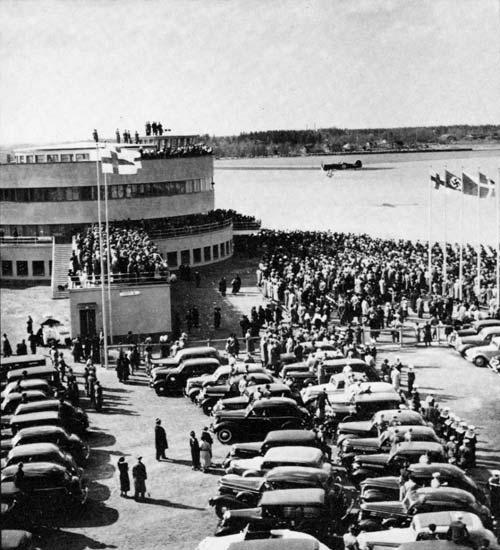
he opening of Helsinki Airport at Malmi, 15 May 1938. Photo: Aarne Pietinen
The day of completion finally dawned, and an exceptionally big opening ceremony was attended by 2,000 invited guests, including among others Prime Minister Cajander, Speaker of Parliament Hakkila, Secretary of State Holsti and other members of the cabinet. General Mannerheim and other representatives of the military high command, almost all of the diplomatic corps, a large group of Members of Parliament and representatives of the City of Helsinki were also all in attendance. A large airshow had been organized by SIPL (the Finnish Air Defense League) and this was watched by 25,000 satisfied viewers. One of the most peculiar specialties was a German autogiro that flew without wings. The autogiro was an early phase in the development of helicopters; rotors replaced the wing and an ordinary airplane propeller maintained airspeed. In those days, industrializing Germany was the leader in aviation, and German aircraft were strongly represented in the programme of the airshow.
In this manner, Malmi Airport also claimed its first victims when a Latvian two-seat sportsplane that had participated in the airshow crashed in the fields of Viikki, killing both pilots. One of them was a Finnish student of technology. The prospects of passenger air traffic were promising. Several foreign airlines, with AB Aerotransport, LOT and Lufthansa at the head, opened regular routes to Helsinki. In 1938, the number of air operations increased in cooperation with Deutsche Lufthansa. Scheduled flights to Germany reached all the way to Königsberg and as mentioned, to Berlin. Aero was looking for larger passenger aircraft.
The German four-engine Focke-Wulf Condor was found suitable and in anticipation of the 1940 Helsinki Olympics, in early 1938 Aero ordered four German Focke-Wulf Fw 200B (Condor) aircraft, to be delivered in early 1939 (OTL, two were ordered in 1939 but were never delivered). Delivered in early 1939, the Condors began to fly two new routes from Malmi – Helsinki-London-New York and Helsinki-Paris-Rome.And with the 1940 Helsinki Olympic Games approaching, the exceptionally stylish and modern airport was completed just in time. It was a handsome showcase of a young, sovereign nation opening its doors to the outside world. In autumn 1939 the north-south runway was already being extended to 4.200 ft with the new large airliners and the lively Olympic traffic in mind and regular flights into Helsinki by KLM and BOAC had begun.
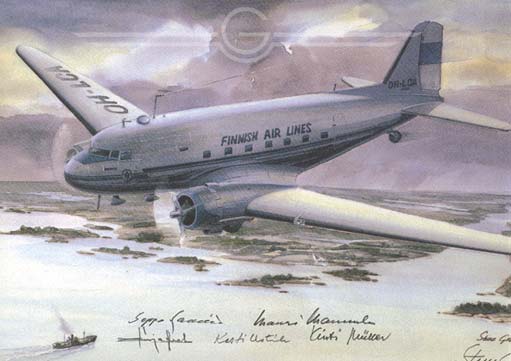
Sotka” The first DC-3 of Aero Oy (1938)
OH-LCA “Sotka” was the first of a series of DC3 aircraft delivered to Finland prior to WW2. They flew as passenger aircraft prior to the Winter War, were mobilized by the Ilmavoimat for the duration of WW2 and post-war, after being refurbished, went back into passenger service with Aero Oy (which was be then renamed Finnish Air Lines). Ten of the DC-3s that survived the war were in operation from 1946 to 1965. The depicted OH-LCA was destroyed in an accident in November 1963. The Print is by Sture Gripenberg, taken from a watercolour (http://personal.eunet.fi/pp/gdes/ENG/21.htm). The proofs are signed by captains Seppo Saario, Mauri Maunola and Börje Hielm, radio operator Kosti Uotila and stewardess Kirsti Müller.
Following its construction, Malmi would go on to become an important base for the Ilmavoimat as it grew in strength in the period leading up to the Winter War and WW2 (as would the other civil airports within Finland). Malmi was also the home of Aero Oy’s maintenance workshops and hangers.
Although much of Finland`s early civilian aviation building heritage has been lost, Finns nevertheless have reason to be proud. Finland still has in active aviation use one of the best preserved early civilian airports in the world, Malmi Airport in Helsinki. The runways and architecturally significant buildings of Malmi Airport have survived in aviation use and in nearly original shape and size. In the present phase of its rich and versatile history, Malmi Airport is one of the most complete and authentic early airport milieus in the world. As such it helps to fill in a gap in the cultural and milieu heritage of international commercial aviation. Malmi Airport has in 1993 been listed in the catalogue of built cultural environments of national significance by the National Bureau of Antiquities and the Ministry of the Environment. It has also been included in the Finnish selection of the international DoCoMoMo organization’s catalogue of significant monuments of modern architecture. As a still active integral piece of aviation building heritage, Malmi Airport is a world-class rarity. The international esteem it enjoys is reflected in the selection of the Airport to the global List of 100 Most Endangered Sites by the World Monuments Fund in 2004-2005 and in 2006-2007. If you do fly through Malmi, do take the time to look at a last surviving example of the early decades of civil aviation in Europe.
Härmälä Airport
Another important field was Härmälä Airport – built in 1936 in Härmälä (a district of Tampere) located some 6 kilometres (3.7 mi) from the centre of Tampere. Härmälä Airport was connected to Helsinki, Vaasa, Oulu and Kemi by Aero O/Y. The first terminal building was built in 1938 as part of the program to develop Finland’s civil aviation infrastructure. Only during the planning of a runway did it become necessary to also construct an actual airport building to serve passengers. The city’s construction office designed, under the leadership of Bertel Strömmer, a one-storey terminal building, which contained a waiting room for the passengers, a bar, an office, and a weather station.
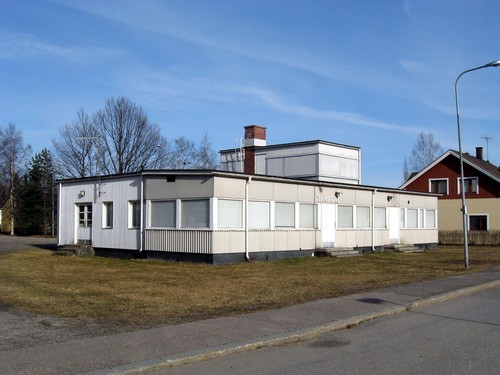
he Photo shows the old Härmälä Airport Terminal and Control Tower, which was built in 1938 (OTL-1941) and used up to 1979. The old airport area has been redeveloped since the 1980’s as a housing area. The old airport terminal has been renovated as an exhibition hall and for sports – Pirkkahalli. All the new street names in the subdivision somehow relate to aviation.
Flight control was placed in the tower section in the middle. The building was designed in a pure functionalist style and it was completed in 1941. The intent was to later expand and raise the building, but the only expansion made was the barrack-like widening of the airfield side in 1964 that has somewhat diminished the original’s clean architecture. Due to the demands placed on air travel by jets, a new airport was constructed at Pirkkala in 1979, leaving the old terminal as the headquarters for a skydiving club for some time. The terminal is historically significant, but its modifications and the changing surroundings have left it somewhat obscured in the middle of Härmälä’s suburban housing. The former runway now serves as a parking lot for the Pirkkahalli exhibition centre.
While Aero Oy was based from Malmi Field outside Helsinki, Härmälä Airport became the base of Veljekset Karhumäki (the “Karhumäki Brothers”) – later to be known as Karhumäki Airways and then as Kar-Air). With the acquisition of the Douglas DC3’s in 1938, Veljekset Karhumäki introduced scheduled routes Tampere-Stockholm, Tampere-Tallinn and Tampere-Copenhagen from the summer of that year, direct flights to Göteborg, Malmö and Luleå in late 1938 and Tampere-Warsaw and Tampere-Berlin in early 1939.. Tampere was an important industrial city, and with Finland’s surging economic growth, Tampere-based companies were doing business across Europe. Based in Tampere as they were, Veljekset Karhumäki capitalised on this growth, enabling business executives and salesmen to fly internationally direct from Tampere rather than via Helsinki.
Following its construction in 1936, Härmälä Airport outside Tampere also became the new home of Valtion Lentokonetehdas (the State Aircraft Factory).
By the end of the 1930’s, the new element and way of travel was finally within the reach of everyman, although not priced as everyday fun. The well-known travel writer Ernst Iso-Keisari (né Lampén) described in the weekly Suomen Kuvalehti in May 1937 a journey on the new domestic route from Helsinki to Vyborg aboard Aero’s De Havilland Dragon Rapide “Salama” (“Lightning”): ”First we’d trudge around the length and breadth of the airfield until the aircraft by and by got off the ground – a lot more softly than a seaplane rises from the surface of water. The weather was fine and the sun was shining full blast. Visibility: absolutely great. The Meteorological Institute had forecast fog and rain, but luckily the prognosis was wrong. The bearded fox-terrieress was licking her moustache out of sheer joy.
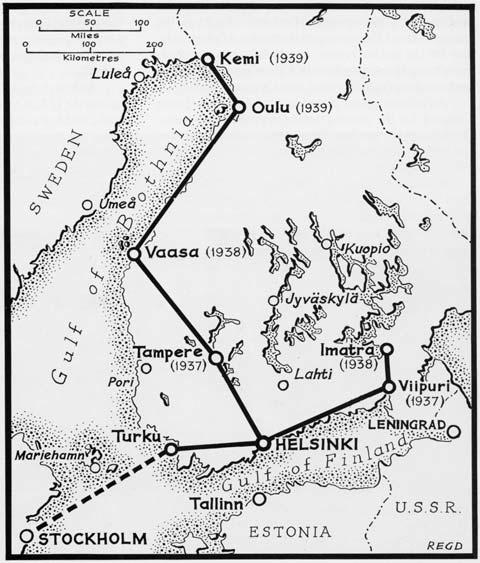
The expansion of Aero’s domestic routes in 1937-1939. Photo: Finnair
So we turned towards the east. No more than eighteen minutes later we saw the Cathedral of Porvoo. Seven minutes later, the tiny town of Loviisa came into view. These towns seemed quite small and insignificant from the altitude of 900 meters. Kotka was somewhat more impressive. We flew straight over the town. (…) We saw the parish village of Säkkijärvi and soon after that the outskirts of Vyborg came to view. The buzz of the engines began to fade to a somewhat less deafening tone. Soon the aircraft began a slow glide downwards, and after no time the airfield of Vyborg was swaying us on its soft sands. The journey had taken exactly 1 hour. What a wonderful journey. The only drawback was that one couldn’t chat at all during that hour because the noise of the aircraft made all conversation impossible. For one whole hour one had to shut up, which was quite an ordeal but nevertheless passed painlessly as there was so much beautiful scenery to look at through the windows.” (…)
”The prices are not at all exorbitant. A round trip to Vyborg costs less than 500 Finnish marks* – only moderately more expensive than a first-class railway ticket. A businessman’s wallet can take it easily if there are important and urgent matters to take care of. An ordinary tourist, on the other hand, gets to see so much beauty that for once in his life it is well worth sacrificing a bit of money to see what our Land of a Thousand Lakes really looks like. I’ll say it again: Finnish landscape is best seen from the edge of the clouds.”
* The purchasing power of 500 Finnish marks in 1937 was equal to about 178 U.S. dollars today. In 1937 the monthly salary of a workman was less than 2000 marks.
Return to Table of Contents
Previous Page:
Next Page:
 Copyright secured by Digiprove © 2015 Alternative Finland
Copyright secured by Digiprove © 2015 Alternative Finland

